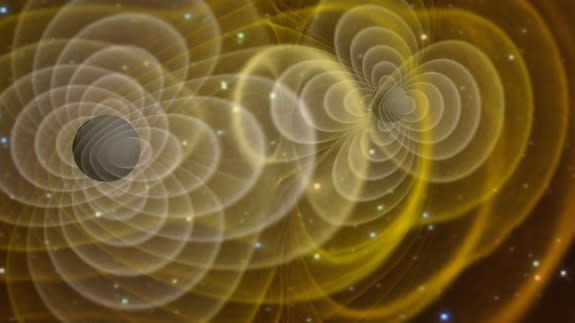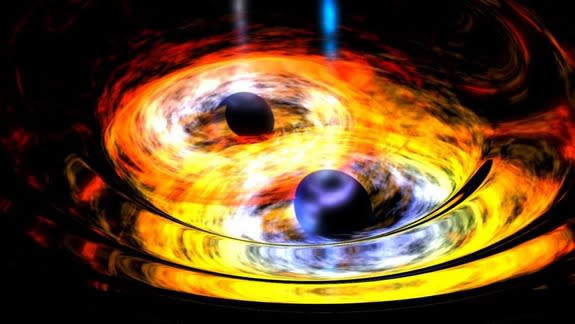Those 2 colliding black holes may have been born in a giant star

The two black holes that sent out ripples in space and time as they merged were born in the belly of a giant star, new research suggests.
The Laser Interferometer Gravitational-wave Observatory (LIGO) caught sight of the two black holes colliding on Sept. 14, 2015, by detecting the gravitational waves — ripples in space-time — sent out by the merger.
SEE ALSO: Einstein was right: Scientists detect gravitational waves for the first time
At about the same time as the merger, the Fermi Space Telescope caught sight of a bright burst coming from the same part of the sky as the black holes.
Gravitational waves are thought to be "dark" events, so finding any kind of bright burst associated with them is surprising, scientists say; however, researchers think they've found some kind of explanation for the burst.
When an incredibly massive star dies, its core can implode, becoming a black hole, but in some cases, if the star is spinning quickly the core can become two black holes instead.
That may have been the case for the two 30-solar-mass black holes seen colliding by LIGO.
Once the two black holes merged into one, it fed off material of the star that bore them, powering jets that flew out from the black hole, creating the burst, according to research done by the Harvard Smithsonian Center for Astrophysics.

Image: NASA
"It's the cosmic equivalent of a pregnant woman carrying twins inside her belly," Harvard astrophysicist Avi Loeb said in a statement.
Gravitational waves are created when two massive objects like black holes or neutron stars collide, sending ripples out through space-time, the fabric of the universe.
Scientists still aren't sure if this burst is definitely associated with the black hole collision, but even if it isn't it could still mean something important for the future of this kind of research.
"Even if the Fermi detection is a false alarm, future LIGO events should be monitored for accompanying light irrespective of whether they originate from black hole mergers," Loeb said. "Nature can always surprise us."
If researchers find more of these kinds of bursts, it could help scientists measure distances across the universe.
"Astrophysical black holes are much simpler than other distance indicators, such as supernovae, since they are fully defined just by their mass and spin," Loeb added.
Scientists announced the detection of the gravitational wave signal to much fanfare on Feb. 11.
The discovery — the first-ever detection of these ripples in space time — could now open up a new way of understanding the universe through gravity. By probing deeply into those ripples, scientists can potentially understand more about the objects that created them.

